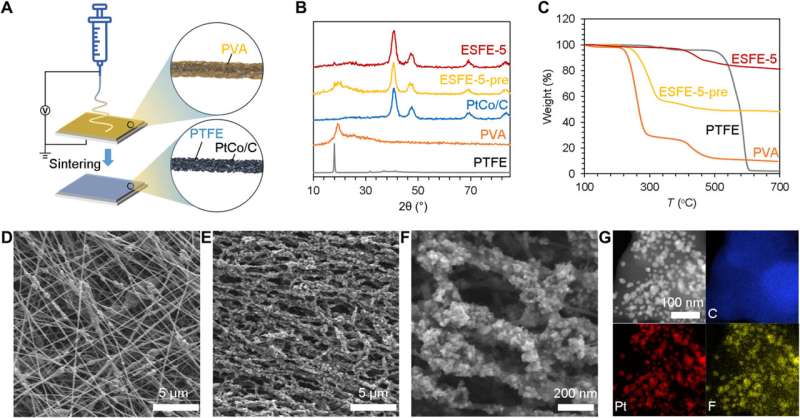This article has been reviewed according to Science X's editorial process and policies. Editors have highlighted the following attributes while ensuring the content's credibility:
fact-checked
peer-reviewed publication
trusted source
proofread
Researchers construct uneven phosphoric acid interfaces for advanced high-temperature polymer electrolyte fuel cells

A research group led by Prof. Wang Suli and Prof. Sun Gongquan from the Dalian Institute of Chemical Physics (DICP) of the Chinese Academy of Science (CAS) constructed uneven phosphoric acid interfaces within the nanofiber electrode for high temperature polymer electrolyte fuel cells (HT-PEFCs), which reduces the resistance of oxygen transport.
This study was published in Science Advances on Jan. 25.
The manufacture, storage, and delivery of highly purified hydrogen are challenging for the commercialization of PEFCs. Elevated temperature (>150 ℃) can realize PEFCs fed with hydrogen-rich product reformed from liquid fuels, which is expected to solve the problem of fuel storage and transportation.
However, insufficient performance with relatively inferior specific power limits the widespread application of HT-PEFCs. Different from the low temperature-PEFCs (LT-PEFCs), liquid phosphoric acid (PA) is adopted to form a proton-conductive phase and electrochemical interfaces within the porous electrodes of HT-PEFCs, leading to ultrahigh mass transport resistance and catalyst poisoning.
In order to reduce mass transport resistance for HT-PEFCs, the researchers designed uneven PA interfacial layers with dispersed droplets by constructing the fibrous electrode architecture. Due to the ultra-hydrophobic nature of the nanofiber networks, PA agglomeration occurred as forms of non-infiltration droplets in the size of micrometer scale, which is different from the traditional immersion model of PA under working circumstances.
This uneven distribution of PA provided reduced thickness and coverage of the PA layers on the surface of catalyst within the porous electrode, leading to a 32% decrease in oxygen interfacial transport resistance and much enhanced electrochemical surface area compared to that of the conventional one.
More information: Zinan Zhang et al, Uneven phosphoric acid interfaces with enhanced electrochemical performance for high-temperature polymer electrolyte fuel cells, Science Advances (2023). DOI: 10.1126/sciadv.ade1194
Journal information: Science Advances
Provided by Chinese Academy of Sciences




















